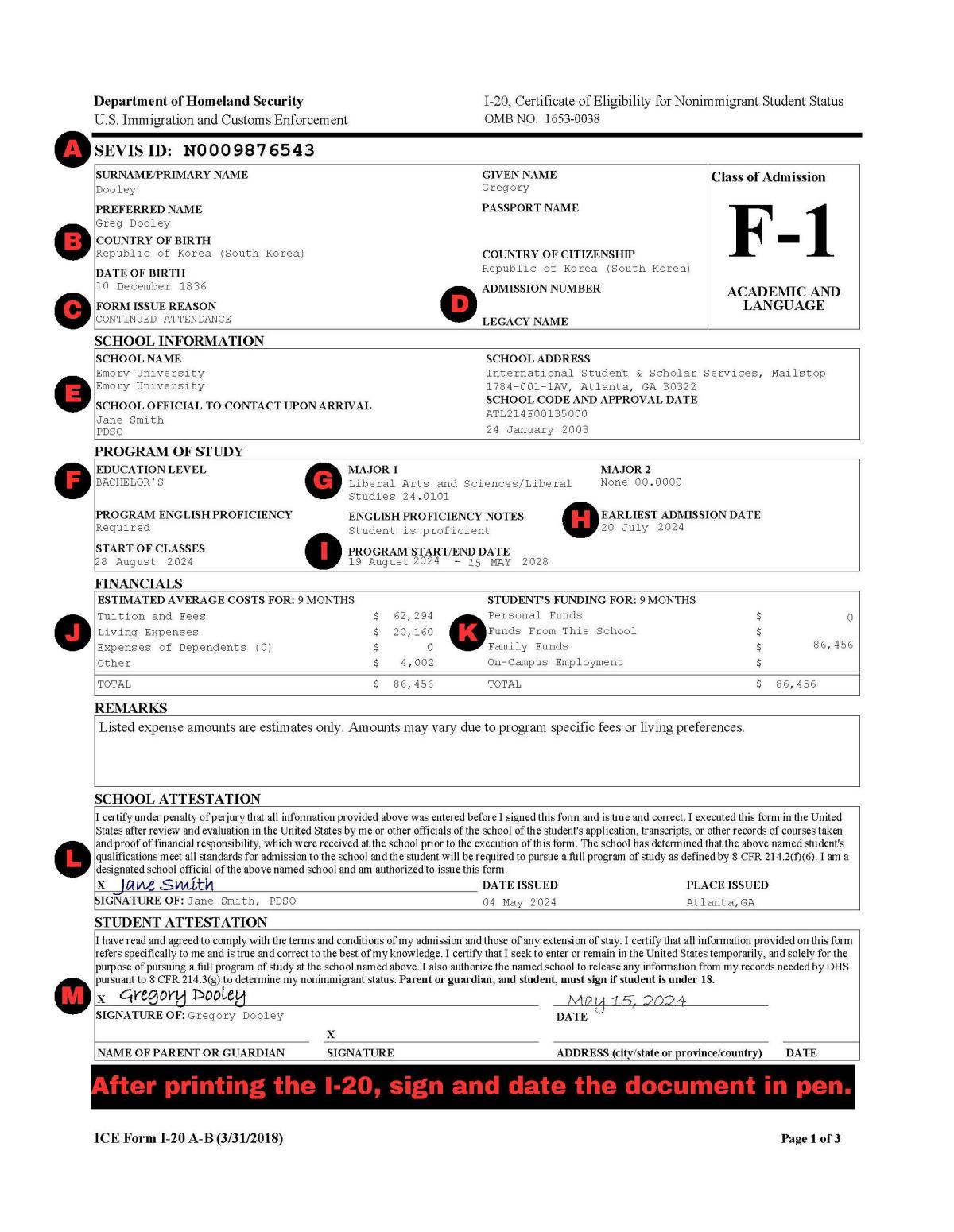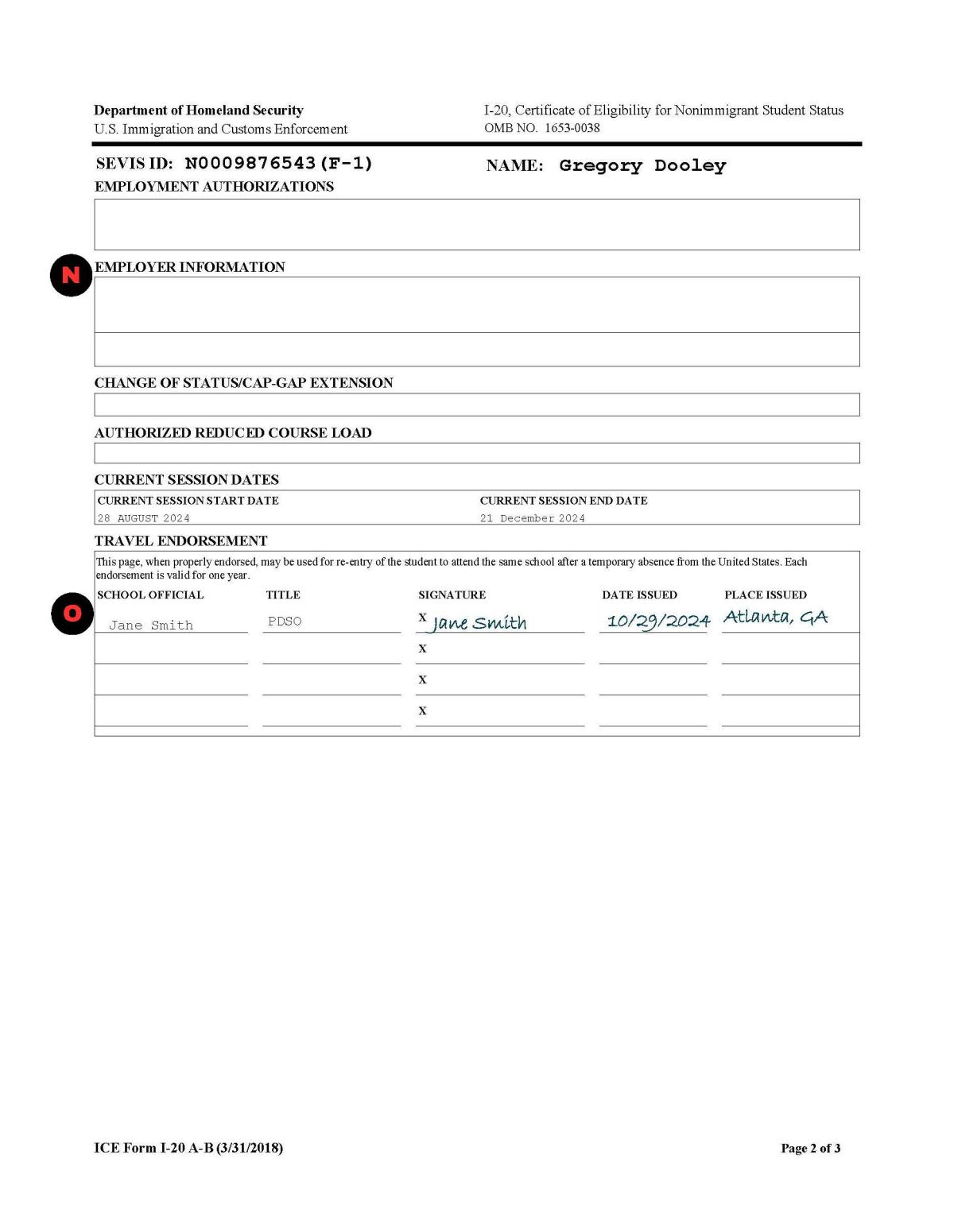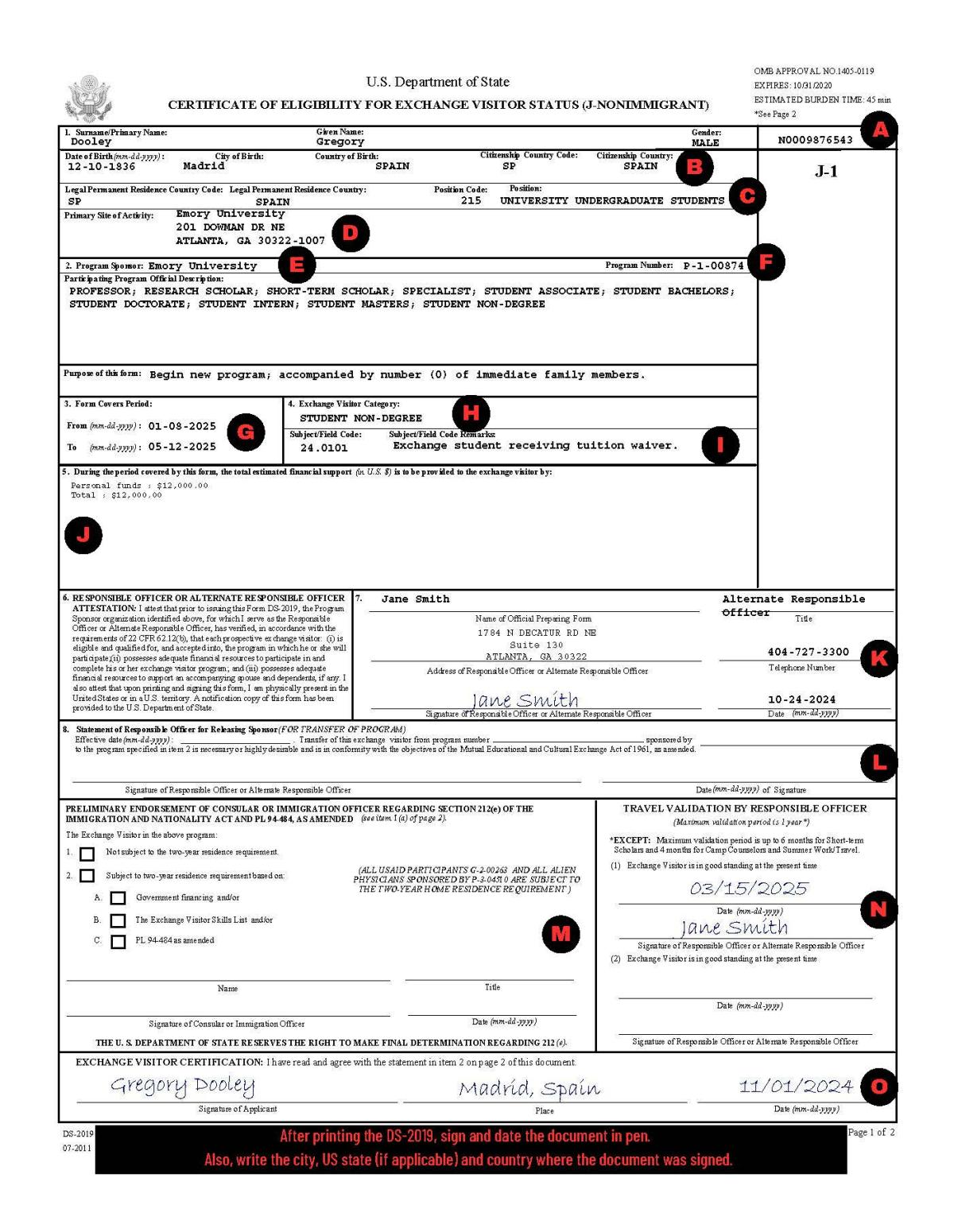Step 2: Understanding the I-20/DS-2019
The Certificate of Eligibility—Form I-20 for F-1 students or Form DS-2019 for J-1 students— is an important document that students will use when applying for their US visa, entering the US and remaining in status during their studies.
New students should review this page to become familiar with reading their initial or transfer-pending I-20 or DS-2019. They should also let their ISSS advisor know if their I-20/DS-2019 has any errors or requires updating.
Title
I-20 Explained (F-1 Students)

A. SEVIS ID: A unique 11-digit alpha-numeric character beginning with “N." This number is generated and assigned to each newly created student, exchange visitor and dependent record in the Student and Exchange Visitor Information System (SEVIS). This number is used to pay the I-901 fee and during the visa application process.
B. Surname/Primary Name, Given Name, Preferred Name, Date of Birth, Country of Birth, and Country of Citizenship: Required biographical information. Passport Name is not a required field and is left blank.
C. Form Issue Reason: For new students, the reason will be "Initial Attendance," "Initial Attendance- Change of Status Requested" (very rare), or "Transfer Pending" (for SEVIS transfer students). Other issuance reasons include: "Continued Attendance," "Reinstatement Requested," or "Use by Dependents for Entering United States." SEVIS transfer students will receive an updated "Continued Attendance" I-20 after completing ISSS' international student check-in process.
D. Admission Number and Legacy Name: Are not required fields and are left blank.
E. School Information: Lists the following information:
- Name of the school that issued the I-20.
- School's SEVIS Code: This code is specific to a campus and acts an identifier in SEVIS.
- Students attending Emory's Atlanta campus will have a SEVIS School Code of ATL214F00135000.
- Student's attending the Oxford campus will have a SEVIS School Code of ATL214F00135001.
- School's contact information.
F. Education Level: The student's degree level. At Emory, options include "Bachelor's," "Master's," or "Doctoral"
G. Major 1 and Major 2: A student's program of study. Sometimes the major(s) listed on the I-20 does not match the name of the Emory academic program. The reason for this difference is due to the US government’s system for tracking fields of study in the US called the Classification of Instructional Program (CIP). Each program of study at Emory is assigned a CIP code which appears next to the program/major’s name on the I-20. Sometimes the Emory program name and the CIP code description are the same and sometimes they differ. Minors are not listed on the I-20.
H. Earliest Admission Date: The earliest date a new student can enter the US. This date will be 30 days before the Program Start Date.
I. Program Start/End Date: The start date is the earliest date a new student should arrive on-campus for a required activity. The Program Start Date is typically different than the Start of Class Date as most new students will be expected to attend an orientation before classes begin. The end date is the estimated date of completion.
J. Estimated Average Costs: The estimated average cost of attendance for one academic year. These figures are determined by the academic program and ISSS.
K. Student's Funding: A breakdown of how the student plans to meet their financial obligations during one academic year. Information listed is based on the financial documentation provided by the student.
Note:
- Even if a student provides proof of funding that exceeds the estimated cost of attendance, this section will always equal the total estimated average cost.
- Funding from family members will be listed as “Family Funds” regardless of the relationship.
- Funds on the I-20 are not binding, therefore updates are not necessary unless there is a significant change.
L. School Attestation: Contains the signature of the ISSS staff member that created the I-20. This staff member is referred to as a Primary Designated School Official (PDSO) or Designated School Official (DSO). Students should feel free to reach out to their PDSO/DSO with any questions that they may have about their I-20!
M. Student Attestation: After printing the I-20, the student will sign and date the I-20 using a pen. The student should only sign this section if they are 18 years old or older. Students who are under 18 will have their parent or guardian sign the second line. Students with F-2 dependents should sign this section on their child's behalf if the child is under 18 years old.

N. Employment Authorizations and Employer Information: This section contains employment information for students who are on OPT and CPT. This section will be blank for all incoming students.
O. Travel Endorsement: This section is required for students who are in the US, wish to travel abroad and plan to return to Emory to continue their studies. New students will not have a travel endorsement/signature on page 2 of their I-20. After a new student enters the US using their F-1 visa and makes plans to travel abroad, they may request a travel signature from ISSS.
Title
DS-2019 Explained (J-1 Students)

A. SEVIS ID: A unique 11-digit alpha-numeric character beginning with “N." This number is generated and assigned to each newly created student, exchange visitor and dependent record in the Student and Exchange Visitor Information System (SEVIS). This number is used to pay the I-901 fee and during the visa application process.
Box 1
B. Surname/Primary Name, Given Name, Gender, Date of Birth, City of Birth, Country of Birth, Citizenship County Code, Citizenship Country, Legal Permanent Residence Country Code and Legal Permanent Residence Country: Required biographical information.
C. Position Code and Position: Refers to the exchange visitor's position at home, not the position they will hold as an exchange visitor at Emory.
D. Primary Site of Activity: For J-1 students sponsored by Emory, the site of activity is Emory's general address.
Box 2
E. Program Sponsor: Lists the name of the school/organization that issued the DS-2019 which acts as the J-1 student's sponsor for immigration purposes. For J-1 students sponsored by Emory, the Program Sponsor is Emory University.
F. Program Number: The sponsoring school/organization's identification code in SEVIS. Emory University's Program code is P-1-00874.
Box 3
G. Form Covers Period: Program's start date and estimated completion date.
Box 4
H. Exchange Visitor Category: For degree seeking students, this section will list the student's degree level (Student Bachelors, Student Masters or Student Doctorate). For exchange students, this section will state "Student Non-Degree."
I. Subject/Field Code and Subject/Field Code Remarks: The Classification of Instructional Program (CIP) code for a student's primary program of study/major and related remarks. CIP codes are used by the US government to track fields of study in the US. Each program of study at Emory is assigned a CIP code.
Box 5
J. Total Estimated Financial Support: A breakdown of how the student plans to meet their financial obligations during the period covered by the form (e.g. estimated program length).
Notes:
- Even if a student provides proof of personal/family funding that exceeds the program's estimated cost of attendance, this section will always equal the total estimated average cost for the entire length of the program.
- Funds on the DS-2019 are not binding, therefore updates are not necessary unless there is a significant change.
Box 6 and 7
K. Responsible Officer or Alternate Responsible Officer Attestation: Contains the signature of the Responsible Officer (RO) or Alternate Responsible Officer (ARO) that created the DS-2019. For J-1 students sponsored by Emory, the A/RO will be an ISSS staff member. Students should feel free to reach out to their ARO/RO with any questions that they may have about their DS-2019!
Box 8
L. Statement of Responsible Officer for Releasing Sponsor (For Transfer of Program): This section is usually left blank unless the student had their SEVIS record transferred from one J-1 sponsor to another (e.g. from Fulbright to Emory).
Additional Boxes
M. Preliminary Endorsement of Consular or Immigration Officer Regarding Section 212(e): To be completed by a US government official during the visa interview or at the port of entry.
N. Travel Validation by Responsible Officer: This section is required for students who are in the US, wish to travel abroad and plan to return to Emory to continue their studies. New students will not have a travel validation/signature. After a new student enters the US using their J-1 visa and makes plans to travel abroad, they may request a travel validation/signature from ISSS.
O. Exchange Visitor Certification: After printing the DS-2019, the J-1 student will sign and date the document using a pen. The student must also write the city, US state (if applicable) and country where the document was signed. If a student has J-2 dependents, the J-2 should sign their own DS-2019, unless the J-2 is under the age of 16, in which case a parent or guardian should sign for the J-2.
